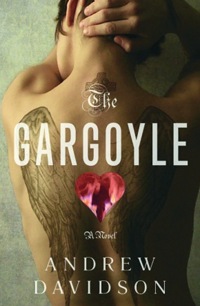 I was so excited to get to read this book. I’ve been hearing about it all over blogs, it’s been popping up in my book radar (out and about) constantly. I only knew that it was about a burn victim who is approached by a woman who says she knows him from a past life. That, and the title, and I was sold! It didn’t hurt the fact that the author is a new Canadian talent!
I was so excited to get to read this book. I’ve been hearing about it all over blogs, it’s been popping up in my book radar (out and about) constantly. I only knew that it was about a burn victim who is approached by a woman who says she knows him from a past life. That, and the title, and I was sold! It didn’t hurt the fact that the author is a new Canadian talent!
You may have noticed that I haven’t had a book review for a while. My knitting friend, Julia, recently asked me if I review every book I read. The answer is yes, at least now. And before I picked up The Gargoyle, I had started and put down a number of novels. I just couldn’t get into them.
Well, you know the writing is powerful when you physically shy away, cringe, and involuntarily shout out because of the graphic descriptions. The novel is written in first person, which initially shocked me, but I grew to really enjoy it. The narrator (whose name we never learn, I just realized) is burned in a car accident after he drives off a cliff trying to get away from his own drug-induced-hallucinations. From there, his life really begins.
This is Andrew Davidson’s first novel, so I went over to the publisher’s website (Random House Canada) to snoop around about him. Here is his bio:
Andrew Davidson was born in Pinawa, Manitoba, and graduated in 1995 from the University of British Columbia with a B.A. in English literature. He has worked as a teacher in Japan, where he has lived on and off, and as a writer of English lessons for Japanese Web sites. The Gargoyle, the product of seven years’ worth of research and composition, is his first book. Davidson lives in Winnipeg, Manitoba.
His book definitely sees into Japanese culture through a minor (yet loved) character, Sayuri. You can’t help but love her! In fact, all the minor characters are well-developed; you learn just enough about them to suppliment the novel’s storyline.
—————————-
I was pulled one way and then the other through the entire story — you don’t know if it’s true when Marianne Engel approaches him and tells him that they were lovers in the fourteenth century. You, like the narrator, probably think she is crazy. But as we learn more of their lives from the fourteenth century, you begin to want to believe Marianne. Whenever she is telling the narrator a story of their past, the narrative switches to first-person-Marianne, which is seamlessly done.
I just read a quote on the back of the cover:
“I was blown away by Andrew Davidson’s The Gargoyle. It reminded me of Life of Pi, with its unanswered (and unanswerable) contradictions…” – Sara Gruen, author of Water for Elephants
Has anyone else read Life of Pi by Yann Martel? Isn’t that just so true!? I didn’t realize it until I read this quote — the story really draws you in with all the contradictions, and the unanswered questions, leaving you to pull out your own conclusions.
I still don’t know what to think — I want to believe it, and I think that I will suspend my logical doubts just to enjoy the story. However, you may have a different conclusion after you meet Marianne and her about her seven hundred years on earth.
—————————-
P.S. The stock photo of the cover does not do it justice. You know that incredible feeling of holding an absolutely gorgeous book? I hope that these photos show how great it was to first hold The Gargoyle.

Full disclosure: I received a copy of the book from the publisher for review purposes. This situation did not affect my review in any way, shape or form.






October 7, 2008 at 8:02 am
This sounds like an amazing book, I’ll have to check it out. Thanks!
October 28, 2008 at 9:59 am
I have this one, but haven’t read it yet. Can’t wait to clear out the TBR pile a bit and get to it. That is a great cover!!